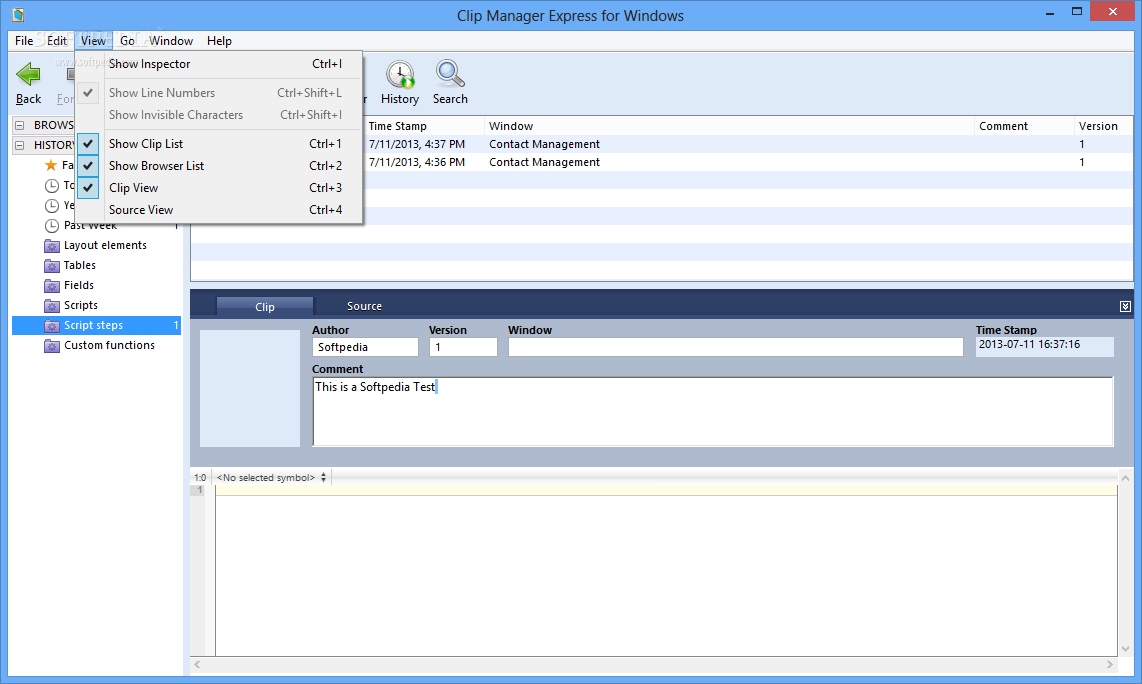

- MEDIA CLIP MANAGER PRO UPDATE
- MEDIA CLIP MANAGER PRO FULL
- MEDIA CLIP MANAGER PRO PRO
 Gamma adjustment-Adjust the gamma transformation applied to the active video pane. You can use the slider to modify the contrast offset, or you can type a value. Contrast adjustment-Adjust the difference between the darkest and lightest colors applied to the active video pane. You can use the slider to modify the brightness offset, or you can type a value. For example, making dark colors lighter and light colors whiter. Brightness adjustment-Adjust the difference between colors and overall lightness applied to the active video pane. These controls are located on the Standalone Video View tab. Video enhancementĮnhance a video stream of image frames with contrast, brightness, gamma, saturation, and color inversion. If multiple video players are open, only the active player will not have the close button the other players will operate in standard mode. If multiple video players are open, the active player will be controlled by the keyboard shortcut keys. The default workspace settings for saving video data is your project geodatabase, with appropriate subdirectories automatically set up for the different types of exported data. Workspace configuration dialog box for your project Define your default geodatabase and folders to save exported metadata files, images, PowerPoint presentations, and video clips for your project. Highlight a video in the Contents pane, select the Standalone Video contextual tab, and click the Configure Workspace button in the Manage group. FMV project settingsĭefining your workspace geodatabases and folders up front allows you to quickly export the different types of data extracted from your videos. It can be resized by grabbing and moving a corner or edge of the player.Ĭhoose a color to identify the video file and associated graphics-such as video footprint-on the map, and feature class data you want to collect on the video. The video player can be moved and placed anywhere on your display. The video player will open with the video file loaded and will be docked below the map.
Gamma adjustment-Adjust the gamma transformation applied to the active video pane. You can use the slider to modify the contrast offset, or you can type a value. Contrast adjustment-Adjust the difference between the darkest and lightest colors applied to the active video pane. You can use the slider to modify the brightness offset, or you can type a value. For example, making dark colors lighter and light colors whiter. Brightness adjustment-Adjust the difference between colors and overall lightness applied to the active video pane. These controls are located on the Standalone Video View tab. Video enhancementĮnhance a video stream of image frames with contrast, brightness, gamma, saturation, and color inversion. If multiple video players are open, only the active player will not have the close button the other players will operate in standard mode. If multiple video players are open, the active player will be controlled by the keyboard shortcut keys. The default workspace settings for saving video data is your project geodatabase, with appropriate subdirectories automatically set up for the different types of exported data. Workspace configuration dialog box for your project Define your default geodatabase and folders to save exported metadata files, images, PowerPoint presentations, and video clips for your project. Highlight a video in the Contents pane, select the Standalone Video contextual tab, and click the Configure Workspace button in the Manage group. FMV project settingsĭefining your workspace geodatabases and folders up front allows you to quickly export the different types of data extracted from your videos. It can be resized by grabbing and moving a corner or edge of the player.Ĭhoose a color to identify the video file and associated graphics-such as video footprint-on the map, and feature class data you want to collect on the video. The video player can be moved and placed anywhere on your display. The video player will open with the video file loaded and will be docked below the map. 
To play an archived video file, browse to the video file and add it to the Contents pane or the display. Video file and associated elements listed in the Contents pane, and displayed on the map. Check the check boxes next to the elements in the Contents pane to display them in the map view. Also listed are the individual elements associated with the video, including Frame Center, Frame Outline, Platform Trail, and Platform Position. When you add a video file to the Map, the video file is listed in the Contents pane. Mark locations and phenomena of interest.Display metadata in real time as the video plays.Use intuitive digital video recorder (DVR) controls, image and video clip capture, and analysis tools.Work with live streams and archived videos.Each video, and its associated graphical information, is identified by a unique color when displayed on the map. Any number of videos can be opened and played at the same time.Thus, any information collected in the video player is projected and displayed on the map, together with your existing GIS data. The video player display and map display are linked with a bidirectional image and map coordinate transformation.
Update the map to zoom to the video frame, or follow videos across the map. Display the video footprint, sensor location, and field of view on the map. The video player is linked to the map display, enabling the following:. The FMV-compliant video data contains camera-pointing information, platform position and attitude, and other data that is encoded into the video stream so that each video frame is associated with geopositional information. These characteristics, and how they affect the FMV player, are outlined below: The characteristics of FMV-compliant video data and ArcGIS Pro determine the form and functionality of the FMV player. The video player experience is similar to the ArcGIS Pro map viewer and can be moved anywhere on your display, resized, minimized, and closed. This unique capability gives the video important geographic context as you view and analyze the data. It works with video data that includes essential geopositional, sensor, and platform orientation information encoded into the video data stream that enables you to know where the video image is placed on a map. With the video player, you can visually analyze video data imagery and collect features of interest.
Keyboard shortcuts for Full Motion Videoįull Motion Video (FMV) in ArcGIS Pro provides the capability to work with archived and live streaming video data using a video viewing and analysis system called the video player. Control playing of the video in the video player.







 0 kommentar(er)
0 kommentar(er)
